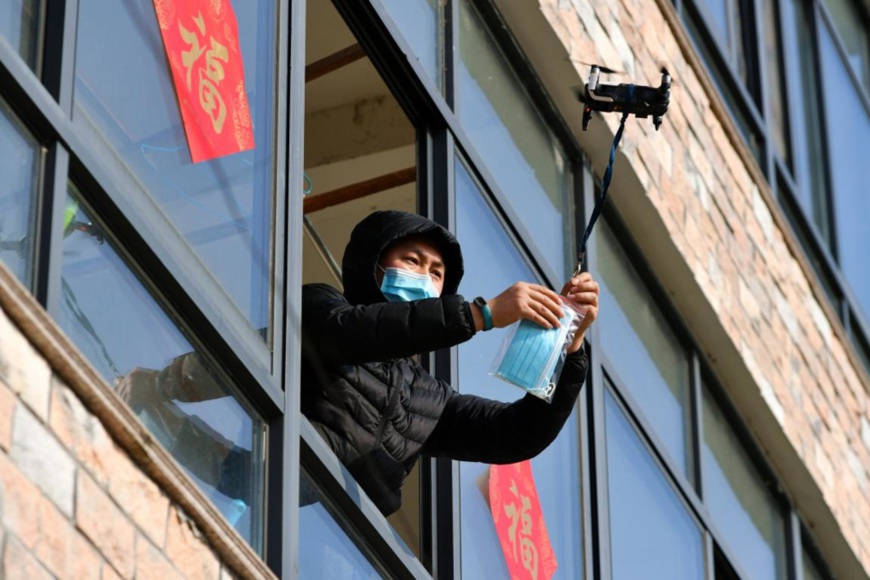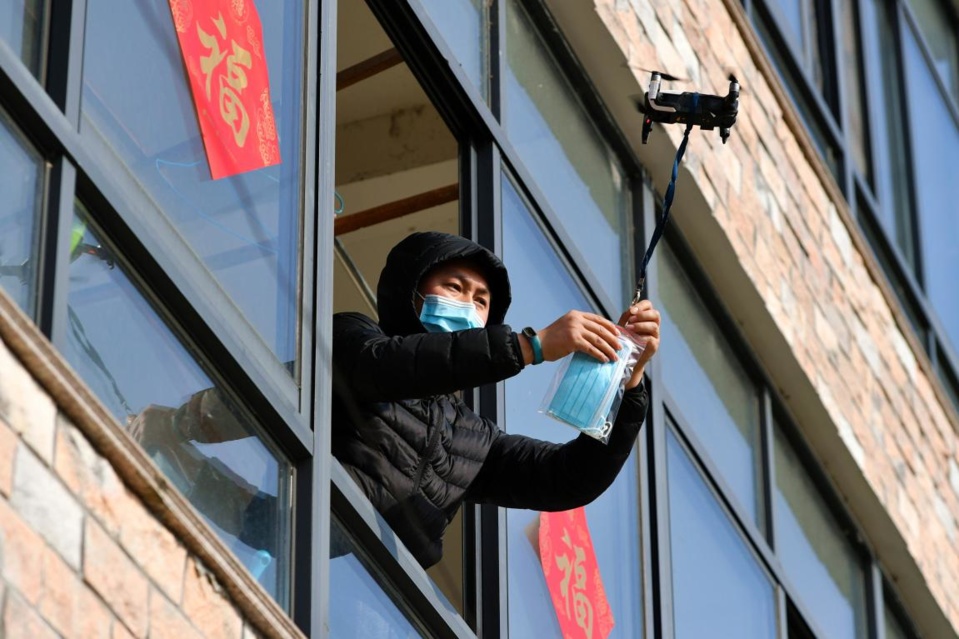By Li Zhen, People’s Daily Overseas Edition

A man in home quarantine in Changping village, Jiapu town, Changxing county, Huzhou, east China’s Zhejiang province, receives face masks and thermometer delivered by a drone on Feb.9, 2020. (Photo by Tan Yunfeng/People’s Daily Online)
New technologies have significantly helped China’s nationwide efforts to fight pneumonia caused by the novel coronavirus (2019-nCoV).
Thanks to new technologies, citizens in home quarantine can check dynamic situation of the epidemic and the distribution density in a heat map at any time, which has been a great help for reducing travel and anxiety of people in quarantine.
Chinese Internet giant Tencent’s information stream service platform has rolled out a function that enables people to search information about communities with cases of novel coronavirus infection.
Covering more than 130 cities, including Beijing, and Shenzhen and Guangzhou in south China’s Guangdong province, the function shows people the number of confirmed cases of novel coronavirus infection and the location of the patients on a map.
“This is a drone equipped with an infrared thermal imaging lens, which helps to observe visible light and infrared light,” said Yi Jinyu, a community worker who was taking residents’ body temperatures with a drone in Yiyang new area of Yichun, east China’s Jiangxi province.
“Within the effective range of three meters, it can measure body temperature with an average error of around 5 percent. The error can be reduced to one percent if the measuring distance is within one meter,” Yi disclosed. The drone helps workers avoid infection when they measure and register people’s body temperatures from door to door.
Besides online information services for citizens in home quarantine, smart products are of great help to people fighting the epidemic in the front line of the battle.
On Feb. 6, a driverless white vehicle running on Jilin street, Qingshan district of Wuhan, capital of central China’s Hubei province, took an express parcel to the gate of Wuhan Ninth Hospital after passing several crossings. Then, the owner of the parcel claimed package by simply clicking on the screen of the vehicle.
It was the first express parcel delivered since the epidemic outbreak. The vehicle was developed by smart delivery robot developed by JD Logistics, the supply chain arm under Chinese online retailer JD.com.
“The smart robot can not only deliver the supplies in shortage to us, but also minimize the possibility of infection by contact. It is such a big help for us,” said the staff member of the hospital who received the parcel.
With drone technology becomes increasingly mature, drones have witnessed more and more extensive application in work of the police.
With wide observation range and broad vision, drones are helpful for reducing the work intensity and risk of infection in the work of the police, said Wen Saiwu, deputy director of the public security bureau of Ruichang, Jiangxi province.
Drones have also helped improve the efficiency of the police’s efforts to carry out epidemic prevention and quarantine inspection, Wen added.
More advanced medical technologies are indispensable to China’s battle against the epidemic and its race against time.
On Feb. 5, a new virus detection lab named “Huoyan” (Fire Eye) was officially put into trial operation in Wuhan. The lab can test as many as 10,000 samples per day, and get the nucleic acid test results in an average of four to six hours.
Huoyan has greatly enhanced the capacity of Wuhan and surrounding cities for detection of the virus since it was put into service.
More high and new technologies are expected to provide all-round assistance for fighting the epidemic in the Huoshenshan Hospital and Leishenshan Hospital, two makeshift hospitals built in Wuhan for treating patients infected by the novel coronavirus.
China’s three major telecommunications operators - China Telecom, China Mobile and China Unicom, have cooperated with multiple manufacturers to complete the construction of a 5G network covering the whole area of Huoshenshan Hospital and a teleconsultation system for Huoshenshan Hospital and the Chinese People’s Liberation Army General Hospital within 36 hours.
China’s tech giant Lenovo offered over 2,000 sets of computers to Huoshenshan Hospital, and sent a professional information technology team to build information system for the hospital.
In addition, Beijing Orion Star Technology Co., Ltd. donated robots that can provide medical services to Huoshenshan Hospital. The robots can perform tasks including delivering laboratory test reports and drugs.
Moreover, such new-tech products as medical apparatus and instruments, as well as air conditioners, thermal image chips, ultraviolet lamps, and dedicated air purifiers for intensive care unit (ICU) wards and operating rooms, have played important roles in fighting the epidemic in a scientific and accurate manner.
Thanks to new technologies, citizens in home quarantine can check dynamic situation of the epidemic and the distribution density in a heat map at any time, which has been a great help for reducing travel and anxiety of people in quarantine.
Chinese Internet giant Tencent’s information stream service platform has rolled out a function that enables people to search information about communities with cases of novel coronavirus infection.
Covering more than 130 cities, including Beijing, and Shenzhen and Guangzhou in south China’s Guangdong province, the function shows people the number of confirmed cases of novel coronavirus infection and the location of the patients on a map.
“This is a drone equipped with an infrared thermal imaging lens, which helps to observe visible light and infrared light,” said Yi Jinyu, a community worker who was taking residents’ body temperatures with a drone in Yiyang new area of Yichun, east China’s Jiangxi province.
“Within the effective range of three meters, it can measure body temperature with an average error of around 5 percent. The error can be reduced to one percent if the measuring distance is within one meter,” Yi disclosed. The drone helps workers avoid infection when they measure and register people’s body temperatures from door to door.
Besides online information services for citizens in home quarantine, smart products are of great help to people fighting the epidemic in the front line of the battle.
On Feb. 6, a driverless white vehicle running on Jilin street, Qingshan district of Wuhan, capital of central China’s Hubei province, took an express parcel to the gate of Wuhan Ninth Hospital after passing several crossings. Then, the owner of the parcel claimed package by simply clicking on the screen of the vehicle.
It was the first express parcel delivered since the epidemic outbreak. The vehicle was developed by smart delivery robot developed by JD Logistics, the supply chain arm under Chinese online retailer JD.com.
“The smart robot can not only deliver the supplies in shortage to us, but also minimize the possibility of infection by contact. It is such a big help for us,” said the staff member of the hospital who received the parcel.
With drone technology becomes increasingly mature, drones have witnessed more and more extensive application in work of the police.
With wide observation range and broad vision, drones are helpful for reducing the work intensity and risk of infection in the work of the police, said Wen Saiwu, deputy director of the public security bureau of Ruichang, Jiangxi province.
Drones have also helped improve the efficiency of the police’s efforts to carry out epidemic prevention and quarantine inspection, Wen added.
More advanced medical technologies are indispensable to China’s battle against the epidemic and its race against time.
On Feb. 5, a new virus detection lab named “Huoyan” (Fire Eye) was officially put into trial operation in Wuhan. The lab can test as many as 10,000 samples per day, and get the nucleic acid test results in an average of four to six hours.
Huoyan has greatly enhanced the capacity of Wuhan and surrounding cities for detection of the virus since it was put into service.
More high and new technologies are expected to provide all-round assistance for fighting the epidemic in the Huoshenshan Hospital and Leishenshan Hospital, two makeshift hospitals built in Wuhan for treating patients infected by the novel coronavirus.
China’s three major telecommunications operators - China Telecom, China Mobile and China Unicom, have cooperated with multiple manufacturers to complete the construction of a 5G network covering the whole area of Huoshenshan Hospital and a teleconsultation system for Huoshenshan Hospital and the Chinese People’s Liberation Army General Hospital within 36 hours.
China’s tech giant Lenovo offered over 2,000 sets of computers to Huoshenshan Hospital, and sent a professional information technology team to build information system for the hospital.
In addition, Beijing Orion Star Technology Co., Ltd. donated robots that can provide medical services to Huoshenshan Hospital. The robots can perform tasks including delivering laboratory test reports and drugs.
Moreover, such new-tech products as medical apparatus and instruments, as well as air conditioners, thermal image chips, ultraviolet lamps, and dedicated air purifiers for intensive care unit (ICU) wards and operating rooms, have played important roles in fighting the epidemic in a scientific and accurate manner.
 Menu
Menu
 New technologies help China fight novel coronavirus epidemic
New technologies help China fight novel coronavirus epidemic
















